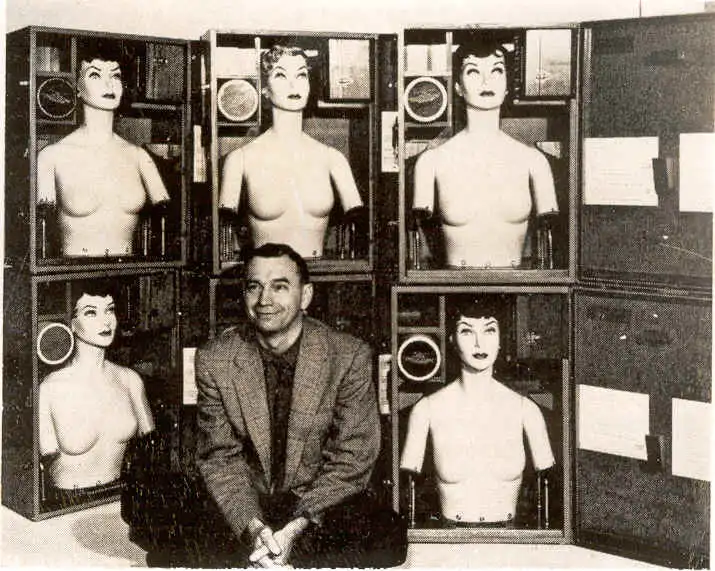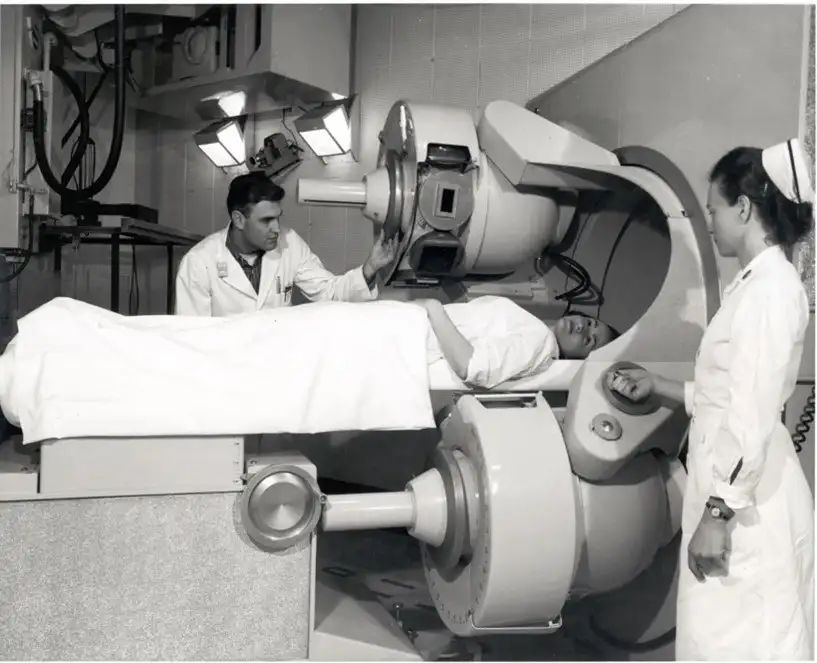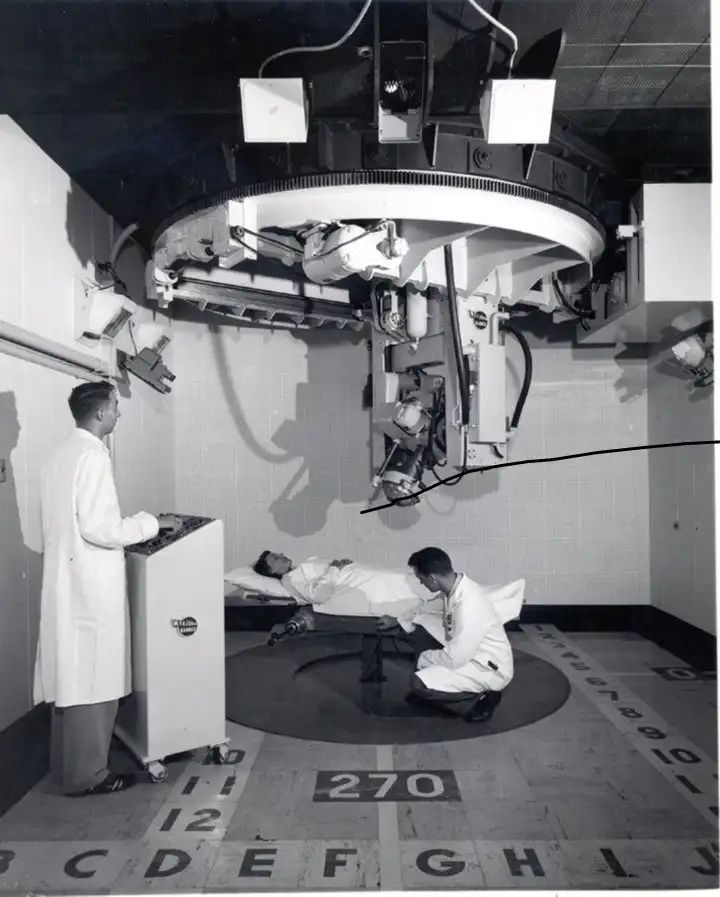
Marshall Brucer, M.D. surrounded by his mannequins
Marshall Brucer, M.D., is one of the founding fathers of the Medical Division at the Oak Ridge Institute of Nuclear Studies (ORINS), which was ORAU’s original name.
Before his time at ORINS, Brucer was a professor of physiology at the University of Texas in Galveston. He was selected from 90 potential candidates to lead the ORINS Medical Division on December 31, 1948, less than two years after ORINS had been established in 1946. Brucer became a recruiter for the Medical Division in its early days, tasked with hiring employees both scientific and administrative to staff the facilities he was simultaneously helping develop.
Brucer’s journey in science began in Chicago, Ill., where he was born and would later attend the University of Chicago. There, he obtained a Bachelor of Science and a Doctor of Medicine degree. A fervent student, he went on to complete hefty amounts of research at his undergraduate institution and interned at the Mallory Institute of Pathology in Boston in the early 1940s.
During the later years of World War II, Brucer took his skills to Camp Mackall, N.C., serving as a surgeon of the Airborne Command in the Airborne Test Board. Most of the medical equipment used by the United States Air Force in the years following the war was first tested by Brucer. Shortly after the war, he went to Santa Fe, N.M., serving a brief stint as a member of the medical staff at Bruns General Hospital before eventually landing a faculty position in the Medical School at the University of Texas in Galveston.
Brucer was the first chairman of the ORINS Medical Division. The cancer research hospital, managed by the ORINS Medical Division, was one of just three established in the United States to pioneer the field of nuclear medicine following the Manhattan Project. Brucer, along with many members of the ORINS medical staff, was a pioneer in the field of nuclear medicine and radiation therapy.
In the 24 years during which the cancer hospital accepted patients, 3,500 people were treated. The patients had received cancer diagnoses of one form or another prior to entering the facility and nearly all the cases were considered terminal.
Under Brucer’s direction, the ORINS Medical Division received international attention and acclaim. During his tenure, more than 200 reports and articles authored by division staff members were published in 65 United States-based and 10 foreign scientific journals. Nearly 70 different radioactive isotopes were investigated for diagnosis and therapeutic use, and numerous advances were made in the design and application of mechanical electronic devices to aid in the handling, administration, detection and evaluation of radioactive substances.

Brucer’s legacy touches many aspects of cancer research, but one of his most important contributions was undoubtedly his work treating thyroid cancer. Thyroid phantoms, developed by Brucer, simulated the human neck and thyroid, and were used for equipment calibration in thyroid uptake studies. These studies were crucial in evaluating thyroid function.
Brucer’s phantoms (also known as standard scanning manikin) were sent to hospitals and medical centers around the world to train personnel in their use for equipment calibration. The standardized model was able to simulate iodine uptake in humans. Brucer recognized the need for a more accurate and realistic way to measure radiation exposure in humans. The thyroid gland is particularly susceptible to damage from radiation exposure because it absorbs and concentrates iodine, which is a common radioactive isotope released in nuclear accidents or incidents. That exposure can lead to thyroid cancer or other thyroid diseases. At the time, doctors had been developing ways to measure thyroid function for a few decades; but there was no consistent method for the field of medicine.
Brucer was also a key contributor to the development of cesium teletherapy, in which cesium was used in place of cobalt to treat cancer. Brucer also helped develop the machines used in cesium teletherapy, like the 1540 curie cesium-137 unit, which targeted diseased tissue and reduced impact on healthy tissue. Dr. Leonard G. Grimmett at Houston’s MD Anderson Hospital in Houston was co-developer.

Brucer began his work in radiotherapy, a cancer treatment that uses radiation to kill cancer cells, around 1951. Brucer tested radioactive cobalt as a means of radiotherapy for cancer patients when he hit on an unexpected breakthrough in using the isotope in place of radium in an X-ray machine. The device, called an “iron maiden,” was installed in Oak Ridge later that year, and not long after was acquired by General Electric for mass production.
Brucer was also a pioneer in the world of breast cancer research. The year 1955 saw Brucer use the “iron maiden” and a metal breastplate device designed specifically for treating cancer of the breast. Its main purpose was to target and kill any cancer cells that would have remained in the person’s body past the point of a surgical removal.
The end of the 1950s saw Brucer named president of the Society of Nuclear Medicine while he also pursued new efforts in radiation and bone marrow transplants. With the help of Dr. Melvin L. Jacobs and physicist Leon Pape, Brucer was part of the team that created a facility at City of Hope Medical Center in Los Angeles that focused on full body radiation. Brucer was an advocate for the treatment of radiation damage, speaking at symposiums on the topic frequently in his later career. He would retire as chairman of the ORINS Medical Division in 1962, making his way from Oak Ridge to Tucson, Ariz.
In his later years, Brucer continued to publish work and kept his name relevant in the world of nuclear medicine. By 1965, he had authored more than 200 scientific publications, and he was awarded the Atomic Energy Commission’s citation for outstanding service. In the 1970s, the University of Arizona was regularly presenting the Marshall Brucer Award for distinguished effort in radiation medicine.
Want to learn more about the early days of ORAU’s history? Be sure to visit our history page to discover how ORAU has transformed to where it is today!